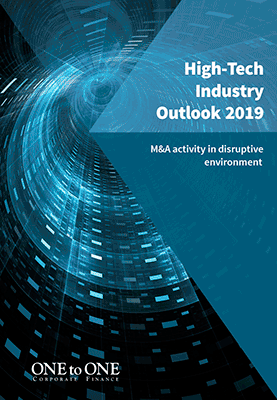PAUL RICHARD HAGER (author) | Partner at ONEtoONE Corporate Finance
BERNAR DE LA HERA (co-author) | Partner ICT Specialist, ONEtoONE Corporate Finance
M&A activity in disruptive environment
Technology is advancing at high speed. Remember how space looked from the flight deck of Star Trek’s Enterprise, just before the ship reached warp speed? The speeding onrush of celestial bodies and the blurring of peripheral view might have made you feel the slightest sense of disorientation, anxiety, imbalance. The barrage of new technological innovations disrupting established industries can be equally disorienting, especially if you’re trying to lead a business. This is basically how the high-tech industry can also be described.
 Today, innovation in key information technologies is fueling change across thousands of products and services. IT is restructuring business models of thousands of companies, driving a trend for a rising number of smaller individual startups and challenging the survival of more consolidated players in the field. Research shows that an increasing number of companies are buying innovative technologies to ensure a smooth adaptation to new processes, products, services, and markets that are created as a consequence of tech innovation. When outsourcing, for example hiring scarce technical expertise compliant with organic growth strategies becomes obsolete, acquiring other companies for that expertise may become a matter of survival.
Today, innovation in key information technologies is fueling change across thousands of products and services. IT is restructuring business models of thousands of companies, driving a trend for a rising number of smaller individual startups and challenging the survival of more consolidated players in the field. Research shows that an increasing number of companies are buying innovative technologies to ensure a smooth adaptation to new processes, products, services, and markets that are created as a consequence of tech innovation. When outsourcing, for example hiring scarce technical expertise compliant with organic growth strategies becomes obsolete, acquiring other companies for that expertise may become a matter of survival.
Leading technologies like the Internet of Things (IoT), Artificial Intelligence (AI), and Blockchain are enabling innovation across a multitude of industries – especially in finance, transportation, agriculture, energy, supply chain, entertainment, healthcare, and bio-engineering. These three technologies eliminate barriers between traditional industry verticals. The result is hybrid companies that can efficiently produce, fulfill, scale, and support successful offerings across multiple verticals – a phenomenon called “Amazoning”. New advanced technologies will also continue to fuel related M&A activity.
When outsourcing, for example hiring scarce technical expertise compliant with organic growth strategies becomes obsolete, acquiring other companies for that expertise may become a matter of survival.
Let’s take a closer look at the mentioned technologies
The internet of things (IoT) – Billions of devices – from home thermostats, to heart pacemakers, to farm machinery, to police surveillance systems – are connected to the Internet and constantly communicating data. Businesses are taking advantage of IoT capabilities to scale for competitive advantage, and at a faster pace than they did cloud-based computing and storage.
The IoT ecosystem enables business intelligence (BI) efforts to apply machine learning on raw customer data pulled from devices and networks scattered around the world. Full use of IoT assets allows companies to measure and manage their global supply chains and operational performance instantly. For instance, retailers are able to real-time track individual product purchases – by customers, time of day, location, and dozens of other parameters.
Blockchain – The benefits of Blockchain technology will totally disrupt how we all live and work. Blockchain is a more specialized, function-specific, and structured application of the IoT schema. It is a highly distributed network of processing nodes (e.g., computers, databases, servers), where every node holds a mapping of the entire blockchain structure (addresses, node identifiers). As these nodes, or “ledgers”, complete a transaction for an “owner”, each transaction is time-stamped and encrypted. As these discrete transactions accumulate, they are grouped together, assigned an identifier, and labeled as a “block”. Strong encryption and multiple copies of each transaction block ensure no transaction record can be altered.
Blockchains have no central authority. They distribute work, according to pre-established order of work, across chain nodes for processing. All transactions are verified in the blockchain process and periodically revalidated to ensure there is no variance between nodes’ copies of each specific transaction. Many industries are taking advantage of blockchain’s processing, documentation, transparency, and securitization features.
Artificial Intelligence (AI) – In the 1950s, ‘60s, and ‘70s, AI was primarily an effort to apply sets of statistical models to discern data trends and perform non-complex problem-solving. Early AI was an attempt to replicate basic human reasoning as it applies to data mining and analysis. Today’s AI has advanced beyond data mining and machine learning – to “deep learning” where the computer can identify, recognize, analyze, and describe data patterns in human terms – to apply and enhance its own models and methods in order to more thoroughly understand data’s meaning. Advances in machine and deep learning now fuel other technologies, such as virtual reality, augmented reality, mixed reality, and natural language processing. In addition, it is very likely that AI will increasingly be used in a wide variety of M&A tasks.
| You may be interested in: Embracing Artificial Intelligence to Enhance M&A |
High-Tech industry M&A Activity
Even as new information technologies are created (such as 5G, quantum, and neuromorphic computing), IoT, AI, and Blockchain will remain as major drivers of related M&A activity. In the attempt to have an overview of the M&A activity in this disruptive environment, we have used in our study a sample of over 5,000 companies and deals from Pitchbook.com advanced search for the high-tech industry for the period 2015-2018. Thus, this research of “disruptive information technology” includes IoT, IA & Machine Learning, Cryptocurrency/Blockchain, Cybersecurity, Fin Tech, Bigdata, Robotics & Drones and Cloud and 3D Printing.
Overall, the data show that there is a surge in the number of large value M&A deals from 2015-2018. VC firms are targeting larger tech players in the innovative information tech sector. The distribution of capital invested demonstrates that the predominant mid-market industry sector receiving investment was advanced IT, accounting for 70% of transactions throughout the period.
Even as new information technologies are created (such as 5G, quantum, and neuromorphic computing), IoT, AI, and Blockchain will remain as major drivers of related M&A activity.
Which industries receive the most capital investments for innovative IT?
Regarding the industries that receive the largest amount of capital investments for innovative IT, the data reveal a fragmented picture of technology application, with some predominant use groups being software (58.88% of all transactions), Other Financial Services applications (7.61%), Commercial services (5.64%) and IT services (4.02%) respectively.
A more thorough analysis can be found in the full report that can be downloaded at the end of this article. The High-Tech Industry Outlook 2019 includes data of capital invested and deal count according to the volume of transactions, the primary country sector, the deal type, and world region.
To sum up, innovation across the IT industry is accelerating at dizzying speeds. Huge technology disruption – in the form of AI, IoT, and blockchain – is fueling other industries’ in-house innovation, and dramatically expanding companies’ capabilities across global markets. Companies are buying innovative IT to ensure their own ability to deliver new technologies, products, and services at accelerating speeds to quickly-evolving global markets. With regards to today’s M&A landscape, these disruptive technologies had the following impact:
- US advanced tech M&A remains strong, but Europe IT M&A is growing
- During a time of falling global Capital Investment activity, rising investment in the IT sector is a bright spot
- Buyers are placing greater emphasis on integrating acquired IT innovation
- Advanced IT remains the hot M&A target.
Download the full report “HIGH-TECH INDUSTRY OUTLOOK 2019” to have a deeper understanding of today´s M&A landscape within the disruptive environment.



